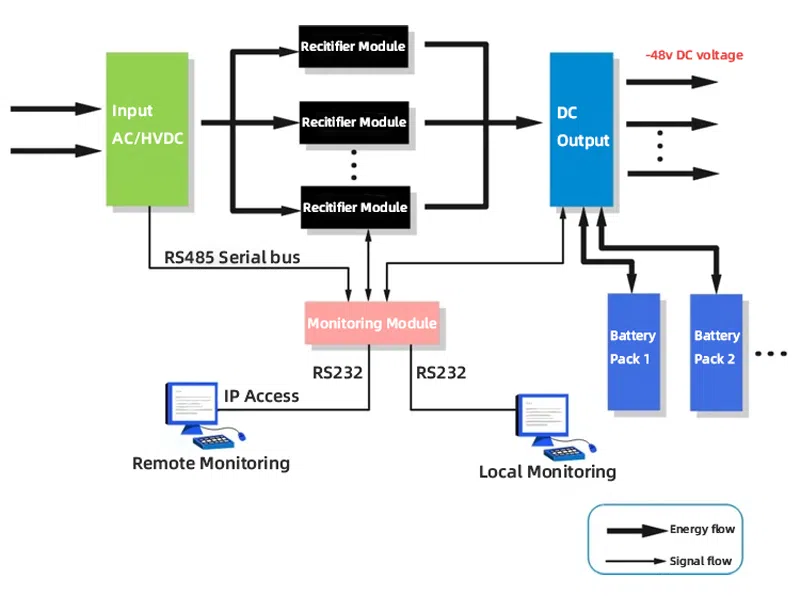لماذا يتم استخدام -48 فولت في مصدر الطاقة للاتصالات؟
Release time: 2025-04-21
Why choose 48V DC voltage instead of other voltages?
Can AC power be used directly?
- EMI & Compatibility: AC’s frequency fluctuations cause strong electromagnetic interference (EMI), disrupting communication device microcircuits. Most components are DC-native; AC use requires costly rectification/filtering, increasing complexity and losses.
- Efficiency & Reliability: AC systems depend on UPS with inefficient AC-DC/DC-AC conversions, high costs, and single-point failure risks (e.g., inverters). 48V DC directly uses battery packs for longer backup and modular reliability.
- Stability & Maintenance: AC’s grid fluctuations demand complex regulation. DC delivers stable power without conversion, cutting faults and eliminating energy loss/maintenance issues from AC multi-stage setups.
Why not use 24V, 36V, or other DC voltages?
- Balancing transmission loss and safety: Lower voltages (e.g., 24V) increase current for the same power (P=UI), leading to higher line losses (Q=I²Rt), overheating, and thicker wiring costs. Higher voltages (e.g., 60V) improve efficiency but raise safety risks (insulation requirements, electric shock hazards). 48V optimizes both aspects.
- Battery compatibility: 48V aligns with common lead-acid battery configurations (24×2V or 4×12V cells), simplifying series connections for balanced charging and longer battery life. Other voltages would require non-standard battery setups.
- Historical and industry standards: Early communication devices (e.g., telephones) adopted 48V DC, establishing a mature technical ecosystem. Shifting to other voltages would incur massive costs and disrupt industry standardization.

Why choose -48V instead of +48V?
- Corrosion reduction: In DC systems, the positive terminal is prone to electrolytic corrosion (due to moisture in the air). With -48V (positive grounded), the positive terminal has no potential difference with ground, minimizing corrosion on critical components (e.g., relay coils). A +48V system (negative grounded) would corrode thinner, more vulnerable parts like coil windings.
- Historical practice and charge flow: Early lead-acid batteries in telephone exchanges used positive grounding for material compatibility and safety. This legacy was preserved through equipment upgrades to maintain compatibility and reduce costs. Additionally, electrons (negatively charged) flow toward the positive terminal in -48V systems, preventing electron accumulation and equipment faults.
What voltage does -53.5V represent?
-53.5V is the float charging voltage for -48V power systems.
To maintain battery health, lead-acid batteries in communication systems are continuously trickle-charged (float charging). The standard float voltage for a 2V cell is 2.20 ~ 2.27V (at 25°C). For a -48V system (24×2V cells), the total float voltage is approximately 2.23V×24 = 53.52V (rounded to -53.5V). This value adjusts with temperature changes to ensure optimal battery performance.

